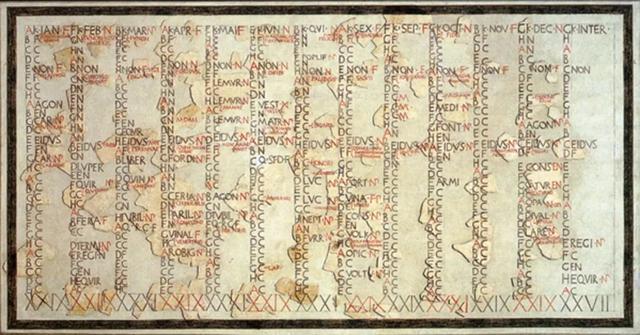【往期回顾】
【本期内容】
History of calendars
早期日历的发展简史

The history of calendars covers practices with ancient roots as people created and used various methods to keep track of days and larger divisions of time. Calendars commonly serve both cultural and practical purposes and are often connected to astronomy and agriculture.
日历的历史涵盖了人们创造和使用各种方法来记录日期和更大的时间划分的古老根源。日历通常既有其文化用途,也有其实用用途,通常与天文学和农业有关。
Archaeologists have reconstructed methods of timekeeping that go back to prehistoric times at least as old as the Neolithic. The natural units for timekeeping used by most historical societies are the day, the solar year and the lunation. Calendars are explicit schemes used for timekeeping. The first historically attested and formulized calendars date to the Bronze Age, dependent on the development of writing in the ancient Near East. In 2000 AD, Victoria, Australia, a Wurdi Youang stone arrangement could date back more than 11,000 years. In 2013, archaeologists unearthed ancient evidence of a 10,000-year-old calendar system in Warren Field, Aberdeenshire. This calendar is the next earliest, or "the first Scottish calendar". The Sumerian calendar was the next earliest, followed by the Egyptian, Assyrian and Elamite calendars.
考古学家重建了至少可以追溯到新石器时代的史前时代的计时方法。大多数历史社会使用的自然计时单位是日、阳历年和阴历月。日历是用于计时的显式方案。第一批经历史证明的系统化的日历可以追溯到青铜时代,这取决于古代近东文字的发展。公元2000年,在澳大利亚维多利亚州,一块伍尔迪尤昂石的排列可以追溯到11000多年前。2013年,考古学家在阿伯丁郡沃伦菲尔德发现了一个有一万年历史的历法系统的古代证据。这个日历是第二早的,或者说是“第一个苏格兰日历”。苏美尔历曾经是第二早的历法,其次是埃及历、亚述历和伊兰历。

The Vikram Samvat has been used by Hindus and Sikhs. One of several regional Hindu calendars in use on the Indian subcontinent, it is based on twelve synodic lunar months and 365 solar days. The lunar year begins with the new moon of the month of Chaitra. This day, known as Chaitra Sukhladi, is a restricted (optional) holiday in India. A number of ancient and medieval inscriptions used the Vikram Samvat. Although it was purportedly named after the legendary king Vikramaditya Samvatsara (‘Samvat’ in short), ‘Samvat’ is a Sanskrit term for ‘year’. Emperor Vikramaditya of Ujjain started Vikram Samvat in 57 BC and it is believed that this calendar follows his victory over the Saka in 56 B.C.
印度教徒和锡克教徒一直使用维克拉姆历。它是印度次大陆使用的几种印度教地区日历之一,以十二个月和365个太阳日为基础。农历的一年从切特拉月的新月开始。这一天被称为印度新年,是印度的一个限制性(可选)假期。许多古代和中世纪的铭文都使用了维克拉姆历。虽然据说它是以传说中的国王Vikramaditya Samvatsara(简称“Samvat”)的名字命名的,但“Sambat”是梵语中“年”的意思。乌贾因的Vikramaditya皇帝于公元前57年创立了维克拉姆历,据信这一历法是在他于公元前56年战胜萨卡之后制定的。
A larger number of calendar systems of the ancient East appear in the Iron Age archaeological record, based on the Assyrian and Babylonian calendars. This includes the calendar of the Persian Empire, which in turn gave rise to the Zoroastrian calendar as well as the Hebrew calendar.
在铁器时代的考古记录中,出现了大量古代东方的历法系统,以亚述和巴比伦历法为基础。这包括波斯帝国的历法,这反过来又产生了琐罗亚斯德教历法和希伯来历法。

Calendars in antiquity were usually lunisolar, depending on the introduction of intercalary months to align the solar and the lunar years. This was mostly based on observation, but there may have been early attempts to model the pattern of intercalation algorithmically, as evidenced in the fragmentary 2nd-century Coligny calendar. Nevertheless, the Roman calendar contained very ancient remnants of a pre-Etruscan 10-month solar year.
古代的历法通常是阴阳历结合的,这取决于闰月的引入,以使阳历和阴历年对齐。这主要是基于观察,但早期可能有人试图用算法对嵌入模式进行建模,如2世纪零碎的科利尼日历所证明的那样。尽管如此,罗马历法包含了前伊特鲁里亚10个月制的阳历年的非常古老的记录方法。
The Roman calendar was reformed by Julius Caesar in 45 BC. The Julian calendar was no longer dependent on the observation of the new moon but simply followed an algorithm of introducing a leap day every four years. This created a dissociation of the calendar month from the lunation.
公元前45年,尤利乌斯·凯撒对罗马历法进行了改革。儒略历不再依赖于新月的观测,而是简单地遵循每四年引入一个闰日的算法。这就造成了阳历月与阴历月的分离。

Sub-Saharan African calendars can vary in days and weeks depending on the kingdom or tribe that created it.
撒哈拉以南非洲的日历可能在几天和几周内有所不同,这取决于创建它的王国或部落。
In the 11th century in Persia, a calendar reform led by Khayyam was announced in 1079, when the length of the year was measured as 365.24219858156 days. Given that the length of the year is changing in the sixth decimal place over a person's lifetime, this is outstandingly accurate. For comparison the length of the year at the end of the 19th century was 365.242196 days, while at the end of the 20th century it was 365.242190 days.
在11世纪的波斯,1079年宣布了由哈亚姆领导的历法改革,当时一年的长度为365.242198585156天。考虑到一个人一生中一年的长度在小数点后第六位发生变化,这是非常准确的。相比之下,19世纪末的一年长度为365.242196天,而20世纪末为365.24219天。
The Gregorian calendar was introduced as a refinement of the Julian calendar in 1582, and is today in worldwide use as the "de facto" calendar for secular purposes.
格里高利历于1582年作为儒略历的改进而引入,如今在世界范围内被用作世俗目的的“事实上的”日历。

【Source】www.en.wikipedia.org
【Translated by】Spark Liao (廖怀宝)
【Illustration】From Bing
